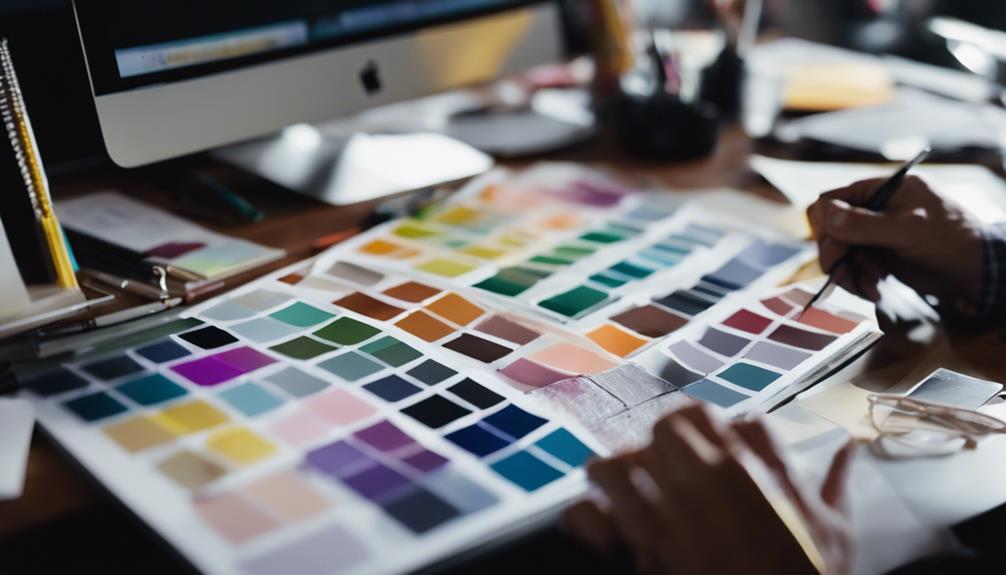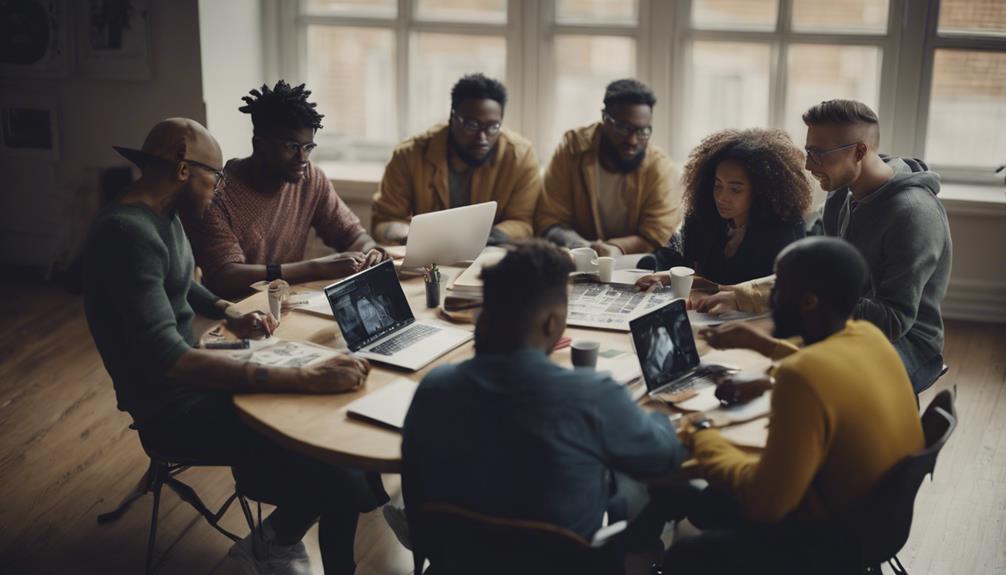In the realm of web design, creativity and innovation are paramount. Yet, even the most seasoned designers can find themselves grappling with a lack of inspiration at times.
So, how does one unlock the floodgates of creativity when faced with a blank canvas and a looming deadline? By following a systematic approach that entails dissecting design briefs, exploring emerging trends, and perhaps even taking cues from the natural world.
But that's just the beginning of a journey towards unlocking a reservoir of design inspiration that can breathe life into your digital creations.
Understanding the Design Brief

In the initial stages of a web design project, gaining a thorough understanding of the design brief is paramount to ensuring the successful execution of the client's vision. Web design companies must carefully analyze the client's requirements, objectives, target audience, and brand identity to create a tailored web design solution. By comprehensively grasping the design brief, web designers can align their web design ideas with the client's goals and preferences.
Effective communication between the client and the web design team is crucial during this phase. Clarifying any ambiguities, asking relevant questions, and actively listening to the client's feedback are essential to develop a design brief that accurately reflects the client's vision. Web design companies should also conduct thorough research on the client's industry, competitors, and target market to gain valuable insights that can inform the design process.
Researching Trending Design Styles
Exploring the latest design trends in the digital landscape provides valuable insights for creating visually compelling and innovative web designs. Keeping up with web design trends is essential for any creative web design agency seeking to stay relevant and competitive in the ever-evolving online world. By researching current web design trends, designers can gain inspiration and understanding of what resonates with audiences, helping them craft user-friendly and aesthetically pleasing websites.
Staying informed about web design inspiration involves studying popular color schemes, typography choices, layout designs, and interactive elements that are trending in the industry. Analyzing successful websites and noting the design elements that make them stand out can provide a roadmap for creating impactful web designs. Additionally, exploring the work of leading creative web design agencies can offer valuable insights and spark new ideas for design projects.
Drawing Inspiration From Nature

To infuse web designs with organic elements and evoke a sense of tranquility, drawing inspiration from nature can elevate the visual appeal and user experience of websites. Incorporating elements such as earthy color palettes, natural textures, and fluid shapes derived from the environment can create a harmonious and visually engaging online presence. By integrating images of landscapes, flora, or fauna, a website can convey a sense of connection to the natural world, instilling a feeling of calmness and authenticity in visitors.
Nature provides an abundance of inspiration for creative web design. From the intricate patterns found in a leaf to the soothing hues of a sunset, the beauty of the natural world can be translated into striking visual elements on a website. Utilizing nature-inspired typography, graphics, and animations can help establish a unique and memorable online identity that resonates with users on a deeper level.
Analyzing Competitor Websites
Upon reviewing competitor websites, one can gain valuable insights into industry trends and best practices in web design. Analyzing the websites of key players in the field, such as web design companies, can provide a wealth of information on current design aesthetics, user experience strategies, and innovative features. By studying the websites of leading web design firms, one can identify common design elements, navigation structures, and content layouts that resonate with target audiences.
In the realm of web design and development, competitor analysis helps in understanding the competitive landscape and positioning one's own web design company effectively. Examining the websites of other web design firms can reveal emerging design trends, technology integrations, and interactive elements that set industry benchmarks. Through a critical evaluation of competitor websites, designers can adapt successful strategies, avoid pitfalls, and stay ahead in the dynamic field of web design. This comprehensive analysis serves as a foundation for creating unique and impactful web designs that resonate with clients and users alike.
Collaborating With Other Creatives

After analyzing competitor websites for valuable insights in web design practices, the next step is to discuss the significance of collaborating with other creatives in the industry. Collaborating with other creatives is essential in the world of web design, especially for web design agencies looking to stay innovative and competitive. By working with other creatives, web design professionals can tap into fresh perspectives, unique ideas, and diverse skill sets that can elevate their projects.
When collaborating with other creatives, whether within your own team or through partnerships with external professionals, it's important to foster open communication and a collaborative spirit. This approach not only enhances the quality of the final product but also promotes a stimulating work environment that nurtures creativity and growth.
For web design agencies, collaborating with other creatives can lead to the development of cutting-edge websites that push boundaries and set new standards in the industry. By leveraging the collective expertise and creativity of a diverse team, web design professionals can deliver exceptional results that resonate with clients and end-users alike.
Experimenting With Color Palettes
Exploring a diverse range of color palettes is integral to crafting visually compelling and harmonious web designs that resonate with users. When it comes to web design inspiration, experimentation with color schemes can make a significant impact on the overall look and feel of a website. Color palettes play a crucial role in evoking emotions, establishing brand identity, and guiding user experience.
To begin experimenting with color palettes, start by researching color theory to understand the psychology behind different hues. Consider the message and tone you want to convey through your website and select a palette that aligns with these objectives. Tools like Adobe Color CC or Coolors can aid in generating cohesive color schemes. Don't be afraid to step out of your comfort zone and try unconventional combinations; sometimes, the most unexpected pairings can result in the most striking designs.
Frequently Asked Questions
How Can I Effectively Communicate With Clients to Ensure Their Input Is Reflected in the Final Web Design?
Effective communication with clients is crucial for reflecting their input in the final web design. Actively listen to their needs, provide regular updates, seek feedback at key milestones, and clarify any uncertainties promptly. Collaboration fosters mutual understanding and ensures client satisfaction.
What Are Some Common Mistakes to Avoid When Incorporating Trending Design Styles Into a Website?
When incorporating trending design styles into a website, it's crucial to strike a balance between innovation and usability. Common mistakes to avoid include overloading with trends, neglecting user experience, and failing to maintain brand identity.
How Can I Use Nature as Inspiration Without Making My Website Look Too Literal or Cliché?
To utilize nature as inspiration for web design without appearing too literal or cliché, focus on extracting abstract concepts like tranquility or growth. Incorporate natural elements subtly through color schemes, textures, or organic shapes to evoke the essence of nature tastefully.
How Can I Differentiate My Website From Competitors While Still Drawing Inspiration From Their Designs?
To differentiate your website from competitors while drawing inspiration from their designs, focus on incorporating unique brand elements, enhancing user experience through innovative features, and incorporating personalized content to create a distinct and memorable online presence.
What Are Some Tips for Effectively Collaborating With Other Creatives to Ensure a Cohesive and Innovative Final Product?
Collaborating with other creatives requires clear communication, shared goals, and respect for diverse perspectives. Encourage open dialogue, provide constructive feedback, and stay focused on the common vision to achieve a cohesive and innovative final product.










